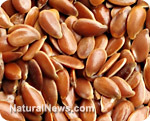
Lignans Shown to Provide Great Benefits for Breast Health
Tuesday, September 30, 2008 by: Barbara L. Minton
Tags: lignans, health news, Natural News
- Newly released JFK files reveal Pentagon's role in creating Lyme disease and covid in the same lab
- Trump's greatest betrayal so far: Accelerating Middle East wars, silencing dissent, and serving Zionist masters
- Trump nominates VACCINE ZEALOT Susan Monarez to lead the CDC, sidelining RFK Jr.'s reform efforts
- The hidden dangers in your kitchen: How cooking methods impact diabetes, cancer and aging
- STARDUST, a secretive Israeli-US startup, plans risky solar geoengineering experiment to BLOCK OUT THE SUN
- DEADLY DECEPTION: How COVID vaccines increased mortality rates and why authorities hid the truth
- Arkansas embraces medical freedom with landmark ivermectin law
- Lab leak confirmed? Boris Johnson's stunning reversal on COVID origins sparks global debate
- Analysis: The coming economic collapse, a mass uprising and Trump's three secret weapons to halt the growing revolt
- The forgotten hormone hero: How vitamin C quietly balances mood, stress and reproductive health
- Festive flavors: The sweet history, nutritional profile and health benefits of pecan pie
- Home gardening for preppers: A beginner's guide to growing your own food
- CDC finally halts $11 billion COVID funding scam as health officials admit the ‘pandemic’ was a fraud
- Elon Musk: Aliens could be here on Earth RIGHT NOW
- Dr. Mike Yeadon releases 15-minute testimony - WATCH - about genocidal intent of COVID “vaccines”
- California's social media censorship law struck down: A victory for free speech or a threat to online safety?
- YouTube’s double standard: CEO defends censorship while claiming free speech champion status
- Sugarcane extract superior to cholesterol-lowering drugs?
- Newly released JFK files reveal Pentagon's role in creating Lyme disease and covid in the same lab
- Elon Musk: Aliens could be here on Earth RIGHT NOW
- Reclaim your health: How midlife exercise reverses years of inactivity
- Trump reverses course on Gaza plan, says “nobody is expelling Palestinians”
- EPA advisor admits the agency is funneling billions to climate groups ahead of Trump’s return to White House
- Big Pharma's $8 Billion bribery scheme exposed: how doctors are pushed to prescribe junk science, not heal
- Space war brewing? Russia threatens to destroy Starlink satellites
- A lack of integrity in Academia: Harvard professor found GUILTY of fraudulent research to promote CRT theory
- Survival 101: Effective EMF blocking techniques
- Rep. Nancy Mace introduces bill to ban biological males from female facilities on federal property
- Mike Adams Sermon 66: God will DESTROY ISRAEL for its wickedness
- Pilots report mysterious lights 'moving at extreme speeds' across Oregon skies
- 5 Simple steps to boost your brainpower: How to strengthen executive function in a distracted world
- Historian warns Israel may be entering an “IRREMEDIABLE DECLINE”
- Florida takes a stand: DeSantis proposes permanent ban on mRNA vaccine mandates
- RFK Jr.'s SSRI antidepressant investigation sparks liberal meltdown, exposes Big Pharma's dangerous game
- OpenAI whistleblower who dissented against how the company trained ChatGPT found dead
- Sugarcane extract superior to cholesterol-lowering drugs?
- EPA advisor admits the agency is funneling billions to climate groups ahead of Trump’s return to White House
- The Health Ranger releases “Vaccine Zombie” song and music video, using AI-animated zombies for the music video
- California's social media censorship law struck down: A victory for free speech or a threat to online safety?
- Dr. Mike Yeadon releases 15-minute testimony - WATCH - about genocidal intent of COVID “vaccines”
- The pandemic as a tool for INDOCTRINATION: Understanding “The Indoctrinated Brain” by Dr. Michael Nehls
- Mike Adams releases country western hit single: Goin’ Back in Time is Comin’ Home
- Mike Adams releases music poetry sensation: A Child of God
- RFK Jr. clears key hurdle: Sen. Susan Collins backs controversial HHS nominee, signaling a new era for health policy
- Florida takes a stand: DeSantis proposes permanent ban on mRNA vaccine mandates
- Unpacking the Lies That We’ve Been Fed – new song and music video released by Mike Adams, the Health Ranger
- Mike Adams releases new song and music video: Nothing More Disgusting Than a Globalist
- Congratulations to the FULLY UNVACCINATED as you resisted the COVID-19 PROPAGANDA MACHINE fueled by over $100 BILLION
- “Why we influenced the 2020 elections”: Facebook files reveal the coordinated effort to bury the Hunter Biden laptop story
- Michigan sheriff announces criminal investigation into 2020 election crimes, Dominion Voting Systems
- Israeli soldiers accused of even more torture and abuse in the West Bank
- Migrants are taking advantage of recent hurricanes to scam residents and loot their homes
- House Intelligence Committee calls for the ARREST and PROSECUTION of Dr. Anthony Fauci
- Peter Rost exposes Big Pharma corruption in his book “The Whistleblower: Confessions of a Healthcare Hitman”
- Red Cross issues warning to stop blood plasma donations from vaccinated people
- Scientists confirm: GENIUS brain function can be spontaneously unleashed in humans without any apparent cause
- EPA advisor admits the agency is funneling billions to climate groups ahead of Trump’s return to White House
- HYSSOP: What research reveals about the health benefits of this ancient holy herb
- Two containers with completed ballots fall out of truck in Florida
- Fully vaccinated about to see “tsunami” of illness and death, warns virologist
- Global leaders unite to clamp down on “misinformation” with UN-backed Cascais Declaration
- BREAKING: 2025 NDAA authorizes mandatory military draft of WOMEN across America… as Pentagon pursues global NUCLEAR war with both Russia and China at the same time
- Michael Yon warns of a ZIONIST TAKEOVER in Trump’s second administration
- BOMBSHELL: DNA testing kits are a SCAM to develop ethnic-specific bioweapons
- Ozempic and Wegovy weight loss drugs are injectable LIZARD VENOM PEPTIDES that may unleash a devastating wave of organ failure… side effects align with symptoms of SNAKE BITES
- Israeli soldiers accused of even more torture and abuse in the West Bank
- These 13 countries just signed an agreement to engineer a global FAMINE by destroying food supply
- NASA admits that climate change occurs because of changes in Earth’s solar orbit, and NOT because of SUVs and fossil fuels
- RFK Jr. clears key hurdle: Sen. Susan Collins backs controversial HHS nominee, signaling a new era for health policy
- Sermon 30: How Jesus reveals Caesar’s FAKE CURRENCY and FALSE AUTHORITY
- Coriander seeds: Ancient medicine backed by modern science
- Arizona officials claim Maricopa County needs 10-13 days to tabulate results of the election
Human lignans are created when natural plant compounds locked into the cellular matrix of certain seeds, beans, legumes, fruits and vegetables are acted upon by bacteria in the digestive tract. These compounds resemble the shape and structure of estrogen and have some of estrogen's functionality. Due to their resemblance to estrogen, lignans are able to compete with estrogen for estrogen receptor sites on breast tissue. When lignans block these receptor sites they reduce the amount of estrogen that can be received in the breast tissue.
Studies have shown that women with the highest levels of lignans in their breasts have the highest levels of breast health. Secoisolariciresinol (SDG) is the natural lignan found in high levels in flaxseed. Studies have shown that when these lignans are present in high amounts in the blood and urine, women have a reduced risk of many chronic diseases including breast cancer and cardiovascular disease.
Flaxseed and its primary lignan SDG have a variety of effects on estrogen metabolism and receptors. When transformed into mammalian lignans by the action of intestinal bacteria they become known as phytoestrogens. The effects of this transformation are readily seen from research findings.
Research findings document the benefits of lignans for breast health
Human-derived breast cancer cells were kept in culture and incubated with mammalian lignans plus estradiol, the most aggressive form of estrogen. Estradiol and the mammalian lignans each stimulated the proliferation of cells, but when combined, no stimulation was seen. The results of the study indicate that mammalian lignans prevent or reduce the binding/metabolism of estradiol within these cells.
Lignans were shown to stimulate the production of sex hormone binding globulin. This globulin, produced in the liver, tightly binds estrogen and reduces the amount of free estrogen circulating in the body that is able to enter tissue. This action effectively reduces the stimulatory effect of estrogen on tissue growth.
In postmenopausal women estrogen is produced through a process called aromatase, the conversion of other hormones to estrogen. When incubated with mammalian lignans, aromatase is inhibited. This action is similar to that of the aromatase inhibiting drugs such as Arimidex and Femara, often prescribed for women who have had breast cancer and want to prevent a recurrence. However, these drugs have horrible side effects.
The highest phytoestrogen consumption and concentrations in biological fluids are seen in countries where cancer incidence is low. The lowest concentrations were found in breast cancer patients or in women at high risk for breast cancer. These findings led researchers to investigate the effects of the SDG found in flax and mammalian lignans for its protective effects in animals. The animals were given a flaxseed supplement along with a carcinogen and a high fat diet. The result was a highly significant reduction in size and number of breast tumors.
A component in the spread (metastasis) of cancer is the ability of tumors to manufacture new blood vessels for themselves from pre-existing blood vessels in a process known as angiogenesis. Animals implanted with a human-derived breast cancer cell line displayed potent metastatic activity. When supplemented with flaxseed meal, they showed significant reduction in tumor growth rate and metastasis. However, the specific protective components of the flaxseeds were not discernible from these two studies.
Two studies attempted to ascertain the most preventive component in flaxseed. In the first, animals were given a breast cancer-causing chemical for 13 weeks, then supplemented with either flaxseed oil containing only trace amounts of SDG, flaxseed meal, or pure SDG. All three supplements reduced tumor size, but only the animals supplemented with pure SDG showed a reduction in both tumor size and the average number of new tumors formed.
In the second study, pure SDG extracted from flaxseed and fed to carcinogen induced animals resulted in a 46% lower number of tumors compared to those not receiving SDG.
In human studies, researchers directly examined the influence of flaxseed and its lignans on breast health in postmenopausal women by expressing the relationship of dietary and urinary lignan concentrations. They used women in Eastern Finland where dietary lignan intake is typically above that of women in the U.S. They found that higher blood concentrations of SDG were linked to a highly significant reduction in breast cancer risk.
Twenty-eight healthy postmenopausal women were studied to determine if flaxseed supplementation altered the metabolism of estrogens. They completed a series of 7 week supplementation periods where they ate their usual diet, took a 5 gram/day supplement of flaxseed meal, or took a 10 gram/day supplement of flaxseed meal. During the periods when the women consumed the flaxseed supplements the concentration of properly metabolized estrogen in the urine increased, with 10 gram/day producing the greatest increase. Additionally, the ratio of properly metabolized estrogen to improperly metabolized estrogen increased with flaxseed, with the 10 gram/day dose eliciting an increase significantly greater than the 5 gram/day dose.
These researchers also evaluated the effects of flaxseed and wheat bran fiber supplementation on estrogen metabolism in 16 healthy premenopausal women for a period of 8 menstrual cycles. The women ate their usual diet and specially prepared baked goods containing either 10 grams ground flaxseed, 28 grams wheat bran fiber, 10 grams ground flaxseed plus 28 grams wheat bran fiber, or no added lignan or fiber source for two consecutive cycles. Only the two treatments where flaxseed baked goods were consumed produced significant alterations in urinary markers of estrogen metabolism. Both resulted in significant increases in proper estrogen metabolism, and the ratio of proper to improper metabolism. Because the flaxseed used in this experiment was low in omega-3 fatty acid and in fiber relative to the wheat bran, the findings reinforce the assertion that SDG is the primary estrogen metabolism modifier present in flaxseed.
Other research compared the effects of flaxseed and soy upon estrogen metabolism. Postmenopausal women received a placebo muffin, a muffin with 25 grams of ground flaxseed, or a muffin with 25 grams of soy daily for 16 weeks. At the end of this period, only the group receiving the flaxseed muffin showed significant increases in good estrogen metabolism and metabolic ratio.
Research also suggests that breast tenderness and pain, known as cyclical mastalgia, may carry an elevated risk of breast cancer. 116 women who had experienced severe cyclical mastalgia for the preceding 6 months were supplemented with flaxseed (25 grams/muffin) or placebo muffins over 3 menstrual cycles. At completion the reduction in breast pain, swelling and lumpiness was significantly lower in the women eating the flaxseed muffin. These women showed an increase in urinary mammalian lignans and a change in circulating estrogen level.
In still another investigation, 39 women newly diagnosed with cancerous breast tumors consumed a muffin containing 25 grams of ground flaxseed meal, or a placebo muffin during the time period following their diagnosis until their surgery. At both points analyses were performed to assess the rate of tumor cell proliferation. In the flaxseed muffin group, factors indicative of tumor growth fell by 21-33%. These women also showed a significant increase in urinary lignans.
These findings are similar to those seen in women with breast cancer receiving tamoxifen under similar conditions. Flaxseed SDG exerts actions like those of tamoxifen without the side effects. They are nature's selective estrogen receptor modulators. Flaxseed lignans are chemically similar to tamoxifen, but because they occur in nature they are easily identified and used by the body. And because they are naturally occurring, the body does not build resistance to them as it does to foreign substances like tamoxifen. Women taking tamoxifen build resistance to the drug and it becomes ineffectual after five years, leaving them vulnerable.
How to make sure you get enough lignans
In order for lignans to effectively compete with estrogen for the estrogen receptor sites, there must be a large number of lignans in the body. This can be accomplished by consistently eating a diet high in lignan precursors including flax seeds or other high lignan producing foods such as garlic, carrots, broccoli, asparagus, and dried apricots and prunes. It can also be accomplished by using high lignan flax oil. High lignan flax oil works well bonded with organic low fat cottage cheese, as the Budwig protocol for cancer prevention and cure has documented.
There are also a number of high lignan SDG products formulated as capsules, the best known of which is Brevail made by the Barleans Company. Barleans also makes top quality organic high lignan flax oil as does Spectrum. These are available at health food stores or from online retailers.
Lignans pass through the body in a 24 to 48 hour period, so care must be taken to eat foods containing lignan precursors on a daily basis. Supplementing with high lignan flax oil or a lignan capsule formulation insures that you will get a quantifiable amount everyday.
Since lignans are created by the action of intestinal bacteria upon the lignan precursors found in certain vegetables and fruits, supplementing with probiotics is a good idea for keeping your intestinal tract well populated with these friendly bacteria. It is crucial to do so following use of antibiotics.
Unlike the diet of our ancestors, today's western diet does not include much in the way of high lignan foods. Add to that the fact that we are not generally as active as our ancestors and hopefully eat less. So the amount of lignans available to us from our food is small. Much of this research suggests that this decreased intake of foods containing lignan precursors has left women without the ability to modulate estrogen naturally.
Reference:
Results from these studies may be viewed in detail at (www.brevail.com)
About the author
Barbara is a school psychologist, a published author in the area of personal finance, a breast cancer survivor using "alternative" treatments, a born existentialist, and a student of nature and all things natural.Lignans at FETCH.news
Get independent news alerts on natural cures, food lab tests, cannabis medicine, science, robotics, drones, privacy and more.
Take Action: Support Natural News by linking to this article from your website
Permalink to this article:
Embed article link: (copy HTML code below):
Reprinting this article:
Non-commercial use OK, cite NaturalNews.com with clickable link.
Follow Natural News on Facebook, Twitter, Google Plus, and Pinterest
Science News & Studies
Medicine News and Information
Food News & Studies
Health News & Studies
Herbs News & Information
Pollution News & Studies
Cancer News & Studies
Climate News & Studies
Survival News & Information
Gear News & Information
News covering technology, stocks, hackers, and more



"Big Tech and mainstream media are constantly trying to silence the independent voices that dare to bring you the truth about toxic food ingredients, dangerous medications and the failed, fraudulent science of the profit-driven medical establishment.
Email is one of the best ways to make sure you stay informed, without the censorship of the tech giants (Google, Apple, Facebook, Twitter, YouTube, etc.). Stay informed and you'll even likely learn information that may help save your own life."
–The Health Ranger, Mike Adams












































